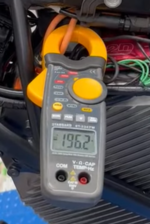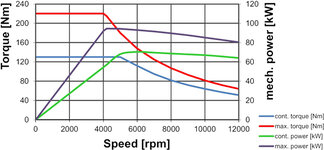I didn't say the Varg has some different/superior/magical vector control scheme. What I said is that current into the D axis does not only weaken the flux in the air gap. It also generates torque and therefore power. Current into the D axis is not wasted. Here, have a look at the torque and power curves to a Brusa HSM1-6.17.12 motor driven by a Brusa DMC524 inverter.
Things are starting to move in the right direction... BRUSA components After I had the chance to meet Mr. Brusa in person (owner of br...

s80ev.blogspot.com
For continuous operation, we have constant torque to 5k RPM and then constant power to 12K RPM. The power is not perfectly flat but it is damn close. It is quite similar to the alta dyno run curves, isn't it?
So how is this possible? It is possible because the motor is designed to do that. It has saliency. This means that D axis current not only weakens the air gap flux, but also applies torque to the rotor. The motor must be designed for this. The inverter must also know how to control the motor in this region of operation. Above 5K RPM the inverter is applying to the motor the maximum voltage possible for the given battery voltage. It is effectively in saturation. The motor is being controlled by the commutation angle. This can be tricky and every motor I have tuned required a slightly different strategy. I am not talking about just changing PI regulator constants and such. I am talking about modification to the vector control algorithm to achieve stability. The transfer from above to below the flux weakening knee can also be tricky.
Now if you take some QSxyz motor and connect it to some Sevcon... First, I doubt the QS was designed with flux weakening in mind (has no or minimal saliency). Designing for efficient operation in the constant power region means you need to make some sacrifices in other areas. Mother nature doesn't give you something without taking something else away.
The Brusa power curves look like they do because the motor was designed to do that. The mathematical model in the inverter corresponds to how the motor behaves. It is this way because the people who made the system worked together and knew what they were doing. Same goes for the Alta. Same goes for the Varg. That is why I stressed the closeness of integration between motor and inverter design at my company. It is what we do. If you could slap together inverter A and motor B and get those results then we would not have a business model.
Someone who slaps together inverter A and motor B and then thinks that that system is pretty close to optimal and a bespoke motor and inverter system cannot do significantly better is just being ignorant.
Regards,
Fran



